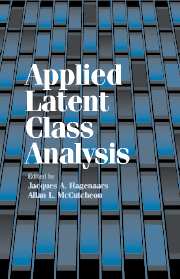Book contents
- Frontmatter
- Contents
- Contributors
- Preface
- INTRODUCTION
- CLASSIFICATION AND MEASUREMENT
- CAUSAL ANALYSIS AND DYNAMIC MODELS
- 8 Use of Categorical and Continuous Covariates in Latent Class Analysis
- 9 Directed Loglinear Modeling with Latent Variables: Causal Models for Categorical Data with Nonsystematic and Systematic Measurement Errors
- 10 Latent Class Models for Longitudinal Data
- 11 Latent Markov Chains
- UNOBSERVED HETEROGENEITY AND NONRESPONSE
- Appendix A: Notational Conventions
- Appendix B: Further Readings
- Appendix C: Selected Software; Webpage
- Index
10 - Latent Class Models for Longitudinal Data
Published online by Cambridge University Press: 31 July 2009
- Frontmatter
- Contents
- Contributors
- Preface
- INTRODUCTION
- CLASSIFICATION AND MEASUREMENT
- CAUSAL ANALYSIS AND DYNAMIC MODELS
- 8 Use of Categorical and Continuous Covariates in Latent Class Analysis
- 9 Directed Loglinear Modeling with Latent Variables: Causal Models for Categorical Data with Nonsystematic and Systematic Measurement Errors
- 10 Latent Class Models for Longitudinal Data
- 11 Latent Markov Chains
- UNOBSERVED HETEROGENEITY AND NONRESPONSE
- Appendix A: Notational Conventions
- Appendix B: Further Readings
- Appendix C: Selected Software; Webpage
- Index
Summary
The work described in this chapter comes from a perspective rooted in psychological research, where there is considerable interest in characteristics of the individual that cannot be directly measured, such as intelligence, abilities in various domains, attitudes, and complex private behaviors. The focus is on using manifest variables, usually subject self-reports or ratings by trained observers, to measure latent variables representing these unmeasured characteristics of individuals. In this chapter, we will discuss the use of latent class models to measure change over time in latent variables.
We will begin by drawing a conceptually important distinction between static and dynamic latent variables (Collins, 1996). Static latent variables are not expected to change over time, or else the change is not of interest in a particular study, as when group differences at a particular time are examined. In contrast, dynamic latent variables do change in systematic and important ways over time. Often the same variable may be thought of as static in one context and dynamic in another, depending on the objectives and interests of a particular research project. For example, drug use in eighth grade, cognitive ability in an elderly population, and gender role identification are all static latent variables. Change in drug use from seventh to ninth grade, age-related decline in cognitive ability, and gender role development throughout high school are all dynamic latent variables.
Growth in continuous dynamic variables proceeds in a strictly quantitative fashion over time.
- Type
- Chapter
- Information
- Applied Latent Class Analysis , pp. 287 - 303Publisher: Cambridge University PressPrint publication year: 2002
- 18
- Cited by



